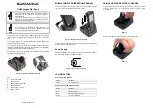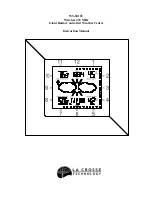
9
Alarm
• Repeatedly press the
MODE
button (35) to access alarm mode 1 or 2.
• A1 or A2 is displayed accordingly in the seconds display.
• Press and hold the
MODE
button (35) for approx. 3 seconds to set the signal time of the alarm displayed.
The hours display begins to flash.
• Press the
+
button (36) or the
–
button (37) to select the hour for the alarm time and confirm your selection
by pressing the
MODE
button (35). The minutes display begins to flash.
• Repeat the process to set the minutes for the alarm time.
• Press the
MODE
button (35) repeatedly to also set the other alarm mode or return to the time display (12).
• If you do not make an entry for 20 seconds, you automatically exit setup mode.
Note – Alarm
• When activated, alarm mode 1 only triggers an alarm signal on weekdays (Monday to Friday).
• When activated, alarm mode 2 only triggers an alarm signal on Saturday and Sunday.
• In alarm mode 1 or 2, press the – button (37) to activate/deactivate the corresponding alarm and confirm
your entry by pressing the
MODE
button (35).
The alarm symbol (27) will appear/not appear.
• If the alarm is triggered, the alarm symbol (27) will begin to flash and an alarm signal will sound.
• Press any button (except the
SNOOZE/LIGHT
button (34) to stop the alarm. Otherwise, it will stop
automatically after 2 minutes.
• If you press the
SNOOZE/LIGHT
button (34) during the alarm, the alarm is interrupted for 5 minutes and
then goes off again. The alarm symbol (27) will flash.
Height/weather forecast/atmospheric pressure unit
• Press and hold the
HISTORY
button (39) for approx. 3 seconds to make the following settings one after
the other:
height of the location, symbol for the current weather conditions, atmospheric pressure unit (hPa/ inhg)
• To select the individual values, press the
+
button (36) or the
–
button (37) and confirm each selection by
pressing the
HISTORY
button (38).
Note
• The height at the current location and the current weather form the basis for calculating the atmospheric
pressure and the weather forecast.
• If you should not know the values for these variables, you can find further information in the Internet,
from the local meteorological office, on the radio, etc.
• We recommend that you adapt these values to your location to increase the accuracy of the weather
forecast.
• A height of 590 m and slightly cloudy weather are used as standard.

































